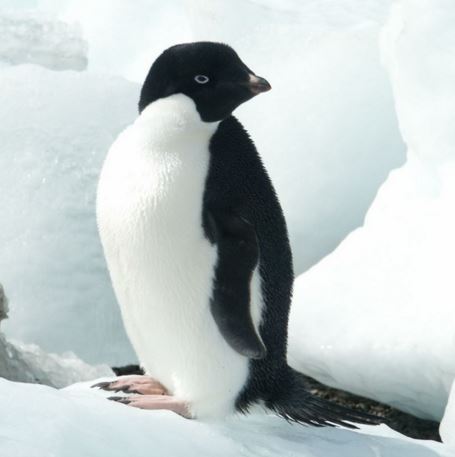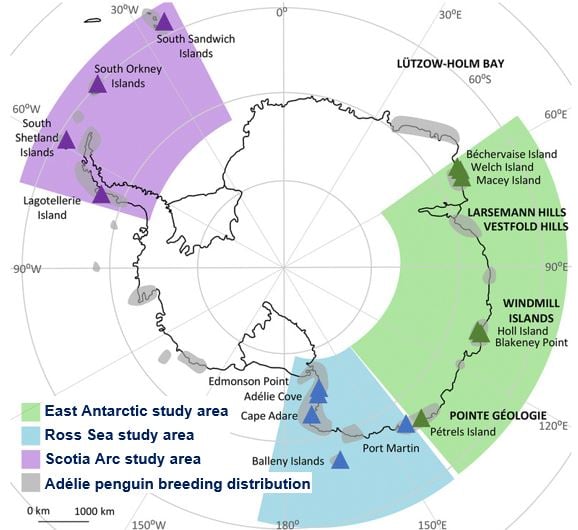Adélie penguins are likely to benefit from shrinking Antarctic glaciers, making them one of the very few species to thrive as a result of climate change, says a team of Australian scientists.
The researchers, from the University of Tasmania, Macquarie University, the Australian Antarctic Division, the Australian National University, and the University of Western Australia, published their findings in the academic journal BMC Evolutionary Biology.
Study leader, researcher Jane Younger from the Institute for Marine and Antarctic Studies (IMAS) at the University of Tasmania, and colleagues studied the DNA of Adélie penguins to track population trends dating back 22,000 years.
 The Adélie penguin (Pygoscelis adeliae) is named after Adélie Pepin, wife of Jules Sébastien César Dumont d’Urville (1790-1842), a French explorer, naval officer and rear admiral, who explored the south and western Pacific, New Zealand, Australia and Antarctica.
The Adélie penguin (Pygoscelis adeliae) is named after Adélie Pepin, wife of Jules Sébastien César Dumont d’Urville (1790-1842), a French explorer, naval officer and rear admiral, who explored the south and western Pacific, New Zealand, Australia and Antarctica.
The team wrote that East Antarctica’s penguin population is 135 times larger today than it was 19,000 years ago, when the last Ice Age ended.
Deglaciation benefits Adélie penguins
Adélie penguins, which nest on ice-free land along the Antarctic coastline, benefit from deglaciation. Foraging for food for their young also becomes easier when there is less sea ice.
Ms. Younger, who was also lead author, said the study demonstrated that when considering climate change’s effects, not only are the immediate impacts important, but the long-term ones over millennia too.
Ms. Younger said:
“We found that the Adélie penguin population in East Antarctica was very small during the ice age, but then penguin numbers increased by roughly 135-fold after the ice age ended.”
The increase began about 14,000 years ago, when glaciers were shrinking in East Antarctica. Retreating glaciers provided additional ice-free ground ideal for Adélie penguin nesting. Unlike other penguins, such as the Emperor penguin, the Adélies do not breed on ice.
However, the authors explained that the benefits for the Adélies could be balanced by climate change’s effect on its main food sources, and more unfavourable conditions in other parts of the Antarctic.
 Breeding distribution of Adélie penguins. Grey shading indicates their approximate current breeding distribution. Green triangles indicate East Antarctic communities sampled in this study, blue and purple triangles indicate colonies in the Ross Sea and Scotia Arc datasets, respectively. (Image: biomedcentral.com)
Breeding distribution of Adélie penguins. Grey shading indicates their approximate current breeding distribution. Green triangles indicate East Antarctic communities sampled in this study, blue and purple triangles indicate colonies in the Ross Sea and Scotia Arc datasets, respectively. (Image: biomedcentral.com)
Global warming not universally good for Adélies
Ms. Younger said:
“For Adélie penguin populations to expand they must have adequate food supplies to meet the requirements of the expanding population. Whether this will be the case in the future remains to be seen, as the impacts of climate change on Adélie penguin prey species, such as Antarctic krill, are unclear at this time.”
“It is very important to note that Adélie penguin numbers are declining in some parts of Antarctica, it would therefore be incorrect to state that climate change is universally good for Adéliee penguins.”
Ms. Younger was joined in the study by co-authors Dr. Patrick Lelliott who works at the Australian School of Advanced Medicine and the Australian National University, Dr. Colin Southwell and Dr. Louise Emmerson from the Australian Antarctic Division, and Dr. Karen Miller from the Australian Institute of Marine Science and the School of Biological Sciences at the University of Tasmania.
The study was supported with a $90,400 grant from the Australian Government’s Australian Antarctic Science Grant Program and $40,286 from the SeaWorld research and Rescue Foundation.
Citation: “Proliferation of East Antarctic Adélie penguins in response to historical deglaciation,” Jane Younger, Louise Emmerson, Colin Southwell, Patrick Lelliott and Karen Miller. BMC Evolutionary Biology. 18 November, 2015. DOI: 10.1186/s12862-015-0502-2.
Video – Facts about Adélie penguins

